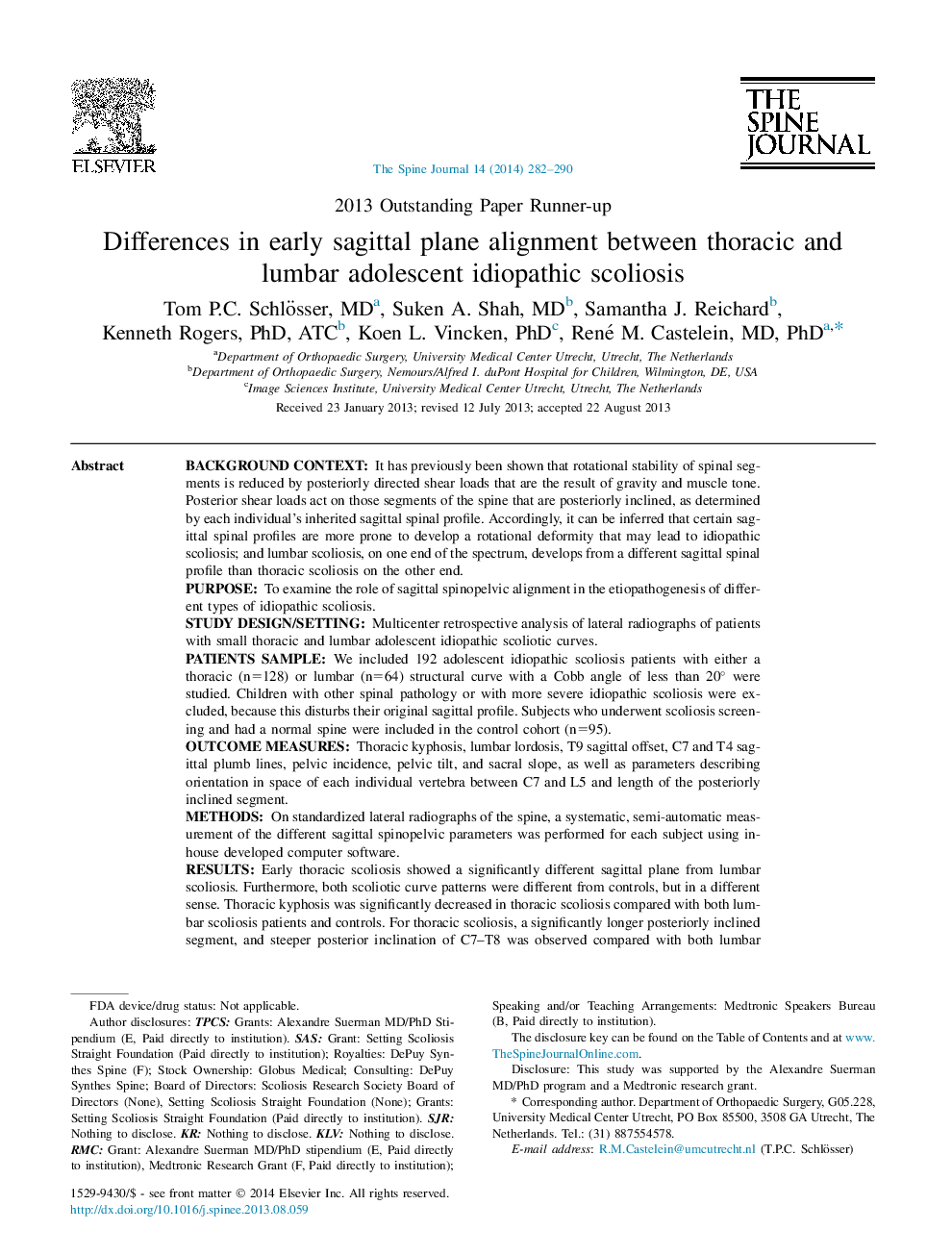| کد مقاله | کد نشریه | سال انتشار | مقاله انگلیسی | نسخه تمام متن |
|---|---|---|---|---|
| 6212884 | 1268605 | 2014 | 9 صفحه PDF | دانلود رایگان |
Background contextIt has previously been shown that rotational stability of spinal segments is reduced by posteriorly directed shear loads that are the result of gravity and muscle tone. Posterior shear loads act on those segments of the spine that are posteriorly inclined, as determined by each individual's inherited sagittal spinal profile. Accordingly, it can be inferred that certain sagittal spinal profiles are more prone to develop a rotational deformity that may lead to idiopathic scoliosis; and lumbar scoliosis, on one end of the spectrum, develops from a different sagittal spinal profile than thoracic scoliosis on the other end.PurposeTo examine the role of sagittal spinopelvic alignment in the etiopathogenesis of different types of idiopathic scoliosis.Study design/settingMulticenter retrospective analysis of lateral radiographs of patients with small thoracic and lumbar adolescent idiopathic scoliotic curves.Patients sampleWe included 192 adolescent idiopathic scoliosis patients with either a thoracic (n=128) or lumbar (n=64) structural curve with a Cobb angle of less than 20° were studied. Children with other spinal pathology or with more severe idiopathic scoliosis were excluded, because this disturbs their original sagittal profile. Subjects who underwent scoliosis screening and had a normal spine were included in the control cohort (n=95).Outcome measuresThoracic kyphosis, lumbar lordosis, T9 sagittal offset, C7 and T4 sagittal plumb lines, pelvic incidence, pelvic tilt, and sacral slope, as well as parameters describing orientation in space of each individual vertebra between C7 and L5 and length of the posteriorly inclined segment.MethodsOn standardized lateral radiographs of the spine, a systematic, semi-automatic measurement of the different sagittal spinopelvic parameters was performed for each subject using in-house developed computer software.ResultsEarly thoracic scoliosis showed a significantly different sagittal plane from lumbar scoliosis. Furthermore, both scoliotic curve patterns were different from controls, but in a different sense. Thoracic kyphosis was significantly decreased in thoracic scoliosis compared with both lumbar scoliosis patients and controls. For thoracic scoliosis, a significantly longer posteriorly inclined segment, and steeper posterior inclination of C7-T8 was observed compared with both lumbar scoliosis and controls. In lumbar scoliosis, the posteriorly inclined segment was shorter and located lower in the spine, and T12-L4 was more posteriorly inclined than in the thoracic group. The lumbar scoliosis cohort had a posteriorly inclined segment of the same length as controls, but T12-L2 showed steeper posterior inclination. Lumbar lordosis, pelvic incidence, pelvic tilt, and sacral slope, however, were similar for the two scoliotic subgroups as well as the controls.ConclusionsThis study demonstrates that even at an early stage in the condition, the sagittal profile of thoracic adolescent idiopathic scoliosis differs significantly from lumbar scoliosis, and both types of scoliosis differ from controls, but in different aspects. This supports the theory that differences in underlying sagittal profile play a role in the development of different types of idiopathic scoliosis.
Journal: The Spine Journal - Volume 14, Issue 2, 1 February 2014, Pages 282-290
